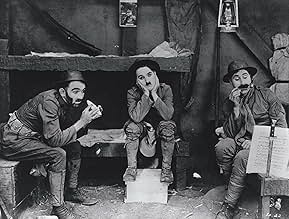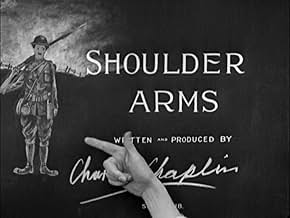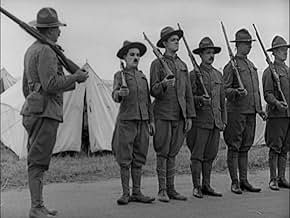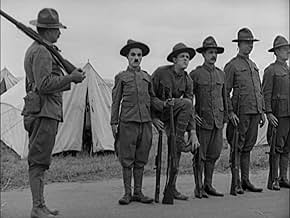NOTE IMDb
7,3/10
7,8 k
MA NOTE
Ajouter une intrigue dans votre langueCharlie is a boot camp private who has a dream of being a hero who goes on a daring mission behind enemy lines.Charlie is a boot camp private who has a dream of being a hero who goes on a daring mission behind enemy lines.Charlie is a boot camp private who has a dream of being a hero who goes on a daring mission behind enemy lines.
- Réalisation
- Scénario
- Casting principal
Charles Chaplin
- Doughboy
- (as Charlie Chaplin)
Syd Chaplin
- Charlie's Comrade
- (as Sydney Chaplin)
- …
W.J. Allen
- Motorcyclist
- (non crédité)
L.A. Blaisdell
- Motorcyclist
- (non crédité)
Alva D. Blake
- U.S. Soldier
- (non crédité)
- …
Cliff Brouwer
- Soldier
- (non crédité)
E. Brucker
- Bit Part in Street Scene
- (non crédité)
F.S. Colby
- Soldier
- (non crédité)
Wellington Cross
- Motorcyclist
- (non crédité)
E.H. Devere
- Bit Part in Street Scene
- (non crédité)
C.L. Dice
- Motorcyclist
- (non crédité)
Avis à la une
Charlie is a boot camp private who has a dream of being a hero who goes on a daring mission behind enemy lines.
"Shoulder Arms" proved to be Chaplin's most popular film, critically and commercially, up to that point. This is understandable given the interesting themes and visual gags. The tree is pretty funny, and the underwater sleeping arrangements are amusing.
What I find particularly interesting about this film's success is how it seems to be now more or less forgotten. I mean, of course any Chaplin film or silent comedy fan will know it. But compared to "The Kid" or "Modern Times" or "City Lights", it is far removed... is this now even one of the top ten most popular Chaplin films?
"Shoulder Arms" proved to be Chaplin's most popular film, critically and commercially, up to that point. This is understandable given the interesting themes and visual gags. The tree is pretty funny, and the underwater sleeping arrangements are amusing.
What I find particularly interesting about this film's success is how it seems to be now more or less forgotten. I mean, of course any Chaplin film or silent comedy fan will know it. But compared to "The Kid" or "Modern Times" or "City Lights", it is far removed... is this now even one of the top ten most popular Chaplin films?
The big names in cinema tried to do their part for the war effort, and Charlie Chaplin was no exception. This patriotic and propagandist picture, "Shoulder Arms", is part of his contribution, although the war was nearly over by the time of its release. The Tramp goes to the front, humorously accomplishes acts of heroism and kicks the Kaiser in the bum. It's a very funny film, although I don't think it nearly one of his best. It's with "A Dog's Life" as his better output for First National before he made his early masterpiece "The Kid". They were his first three-reelers, which contain sustained, more elaborate gags than he could usually orchestrate in his two-reel shorts at Mutual.
It can be difficult to balance a pro-war message with slapstick antics and scenes of burlesque in battle, but one wouldn't think so watching "Shoulder Arms". It's also preferable in many respects to a "more serious", dramatic work with a similar message, such as Griffith's "Hearts of the World". Chaplin had become a true virtuoso of screen comedy by this time; he makes it look effortless. He knew very well by then that a film with fewer gags--with more elaboration, refinement and careful timing--could be better than any knockabout, Keystone-type farce with a dozen pratfalls a minute. The sequence where Chaplin is disguised as a tree is a pertinent example. Even with wars raging, Chaplin can lift the spirits of millions.
It can be difficult to balance a pro-war message with slapstick antics and scenes of burlesque in battle, but one wouldn't think so watching "Shoulder Arms". It's also preferable in many respects to a "more serious", dramatic work with a similar message, such as Griffith's "Hearts of the World". Chaplin had become a true virtuoso of screen comedy by this time; he makes it look effortless. He knew very well by then that a film with fewer gags--with more elaboration, refinement and careful timing--could be better than any knockabout, Keystone-type farce with a dozen pratfalls a minute. The sequence where Chaplin is disguised as a tree is a pertinent example. Even with wars raging, Chaplin can lift the spirits of millions.
One of the prices of superstardom is that you have to become adaptable. When the US joined the World War in 1917 Charlie Chaplin was at the height of his popularity. Naturally, he was expected to make some sort of contribution. Chaplin had already set his short films in all sorts of locations, even at different time periods, and had given his little tramp all manner of occupations, so soldiering in the trenches shouldn't have been too big a step. However, Shoulder Arms is, if not a propaganda piece (it was released a bit late for that), at least one that had to have a certain outlook. As a result Chaplin was constrained somewhat, and it shows.
The first half of the picture, which is set during Charlie's training and among his comrades in the trench seems a little muted compared to other Chaplin pictures of this period. The reason for this is clear – it wouldn't have had the right effect if there were seen to be too much antagonism between soldiers. Characters like the burly drill sergeant or Charlie's buddy (played his brother Syd) would make ideal bugbears in any other picture, but here all we get is a bit of appropriately brotherly tussling between Charlie and Syd. When you see how weak these opening ten minutes are you realise how much of Chaplin's comedy depended upon playing off others and pricking pomposity.
Fortunately, Chaplin gets to make up for all this when his little tramp goes out to face the German foe. Here he can go all out with making his enemies look ridiculous, getting the most out of his varyingly-sized supporting players. We have Henry Bergman as a roly-poly German, Albert Austin as a gangly one, and best of all Loyal Underwood as a short but self-important German officer. This is Underwood's finest moment, and he really puts a lot of energy and spirit into the part. And Chaplin gets to set up some great routines, with some ingenious ways of defeating foes, not to mention one of his best ever entrances when he appears out of the landscape in his tree disguise.
And Chaplin was clearly savvy enough to realise that the beginning of the picture contained some fairly poor material. Consequently he edits in a handful of shots of antics in the German trench (with Underwood at his most animated), which serve as nothing more than a little touch of uproar, and a promise of things to come.
And now we must have that all-important statistic – Number of kicks up the arse: 7 (1 for, 0 against, 6 other)
The first half of the picture, which is set during Charlie's training and among his comrades in the trench seems a little muted compared to other Chaplin pictures of this period. The reason for this is clear – it wouldn't have had the right effect if there were seen to be too much antagonism between soldiers. Characters like the burly drill sergeant or Charlie's buddy (played his brother Syd) would make ideal bugbears in any other picture, but here all we get is a bit of appropriately brotherly tussling between Charlie and Syd. When you see how weak these opening ten minutes are you realise how much of Chaplin's comedy depended upon playing off others and pricking pomposity.
Fortunately, Chaplin gets to make up for all this when his little tramp goes out to face the German foe. Here he can go all out with making his enemies look ridiculous, getting the most out of his varyingly-sized supporting players. We have Henry Bergman as a roly-poly German, Albert Austin as a gangly one, and best of all Loyal Underwood as a short but self-important German officer. This is Underwood's finest moment, and he really puts a lot of energy and spirit into the part. And Chaplin gets to set up some great routines, with some ingenious ways of defeating foes, not to mention one of his best ever entrances when he appears out of the landscape in his tree disguise.
And Chaplin was clearly savvy enough to realise that the beginning of the picture contained some fairly poor material. Consequently he edits in a handful of shots of antics in the German trench (with Underwood at his most animated), which serve as nothing more than a little touch of uproar, and a promise of things to come.
And now we must have that all-important statistic – Number of kicks up the arse: 7 (1 for, 0 against, 6 other)
Charlie Chaplin's Little Tramp or Little Man character wins World War I, called The Great War at the time, single handedly, even capturing the Kaiser, something the entire Allied armed forces were unable to do. Too bad it all turns out to be a dream, which is somewhat of a cop out and the weakest part of this mesmerizing silent short (almost a feature film at 46 minutes).
There are inventive gags galore including Charlie having to put on a gas mask to eat Limburger cheese sent from home, then using the cheese as a weapon against the Germans; Charlie sleeping underwater in a flooded trench next to a soldier he continues to annoy; Charlie disguising himself as a tree--one of his best sketches ever--and Charlie pretending to beat up his friend who has become a POW, then hugging him when the enemy is out of sight.
One amazing feature is how much Charlie, when he is behind enemy lines dressed as a German, resembles Hitler over ten years before Hitler and his Nazi thugs rose to dominate German politics. Obviously Hitler patterned his appearance after Charlie's from this film.
There are inventive gags galore including Charlie having to put on a gas mask to eat Limburger cheese sent from home, then using the cheese as a weapon against the Germans; Charlie sleeping underwater in a flooded trench next to a soldier he continues to annoy; Charlie disguising himself as a tree--one of his best sketches ever--and Charlie pretending to beat up his friend who has become a POW, then hugging him when the enemy is out of sight.
One amazing feature is how much Charlie, when he is behind enemy lines dressed as a German, resembles Hitler over ten years before Hitler and his Nazi thugs rose to dominate German politics. Obviously Hitler patterned his appearance after Charlie's from this film.
In these modern times (as subject known quite well to the director of the short film that this German count is going to talk about
), politically correct films are the "leitmotiv" of the modern young filmmakers' projects. "Shoulder Arms" directed by Herr Charlie Chaplin during WWI (the film was released only a few weeks before the armistice) is an obvious example of why the early cinema pioneers were a very bold people, certainly! To direct a humorous film inspired in the terrible, bloody First World War was a complicated matter that only few directors with those dangerous and daring ideas could be allowed to do
to venture upon such delicate enterprise and with success was reserved only to geniuses.
As this German count said, "Shoulder Arms" was made during WWI, that time in where definitely the whole world lost its innocence (fortunately not the German fat heiresses of this aristocrat ) and it is a hilarious, inventive social satire about that and any war. The film it is full of great gags and entertaining film continuity for a story in where that tramp will live though risky and courageous adventures in the front whether a hero for the allies or not.
To mock the war trenches, the unhealthiness, the frontal attacks and the Germans (how you dare!!... by the way, there are a lot of inaccuracies in the film the German soldiers by that time had moustaches and longer beards not to mention that the Kaiser lacks many medals in his uniform ) in an elegant, funny and delicate way it is even today a film miracle impossible of being surpassed. Keeping in mind those terrible wartime circumstances, the difficult task is only possible thanks to a lot of creativity and talent. Obviously Herr Charlie Chaplin had very much of it.
And now, if you'll allow me, I must temporarily take my leave because this German Count must go back to the Schloss trenches.
Herr Graf Ferdinand Von Galitzien http://ferdinandvongalitzien.blogspot.com/
As this German count said, "Shoulder Arms" was made during WWI, that time in where definitely the whole world lost its innocence (fortunately not the German fat heiresses of this aristocrat ) and it is a hilarious, inventive social satire about that and any war. The film it is full of great gags and entertaining film continuity for a story in where that tramp will live though risky and courageous adventures in the front whether a hero for the allies or not.
To mock the war trenches, the unhealthiness, the frontal attacks and the Germans (how you dare!!... by the way, there are a lot of inaccuracies in the film the German soldiers by that time had moustaches and longer beards not to mention that the Kaiser lacks many medals in his uniform ) in an elegant, funny and delicate way it is even today a film miracle impossible of being surpassed. Keeping in mind those terrible wartime circumstances, the difficult task is only possible thanks to a lot of creativity and talent. Obviously Herr Charlie Chaplin had very much of it.
And now, if you'll allow me, I must temporarily take my leave because this German Count must go back to the Schloss trenches.
Herr Graf Ferdinand Von Galitzien http://ferdinandvongalitzien.blogspot.com/
Le saviez-vous
- AnecdotesMany in Hollywood were nervous that one of their most famous peers was going to tackle the subject of WWI. It was released shortly before the Armistice, so it did not help boost national morale, but it did end up as one of Charles Chaplin's most popular films, and it was particularly popular with returning doughboys.
- GaffesIn the woods, where The Doughboy runs to hide from the pursuing Germans, automobiles are visible traveling on a highway on the horizon.
- Crédits fousThe short opens with a title card showing a caricature of Chaplin dressed as a World War I soldier, and text reading "Shoulder Arms Written and Produced by" followed by a blank space. A live action hand appears and points to the title, then the drawing, then uses a piece of white chalk to sign "Charles Chaplin" in the blank space, then points to the caricature one more time.
- ConnexionsEdited into The Chaplin Revue (1959)
Meilleurs choix
Connectez-vous pour évaluer et suivre la liste de favoris afin de recevoir des recommandations personnalisées
Détails
- Date de sortie
- Pays d’origine
- Sites officiels
- Langues
- Aussi connu sous le nom de
- Shoulder Arms
- Lieux de tournage
- 7th Street and Broadway, Downtown, Los Angeles, Californie, États-Unis(traffic cop trouble in front of Bullock's Department Store.)
- Société de production
- Voir plus de crédits d'entreprise sur IMDbPro
- Durée36 minutes
- Couleur
- Mixage
- Rapport de forme
- 1.33 : 1
Contribuer à cette page
Suggérer une modification ou ajouter du contenu manquant















